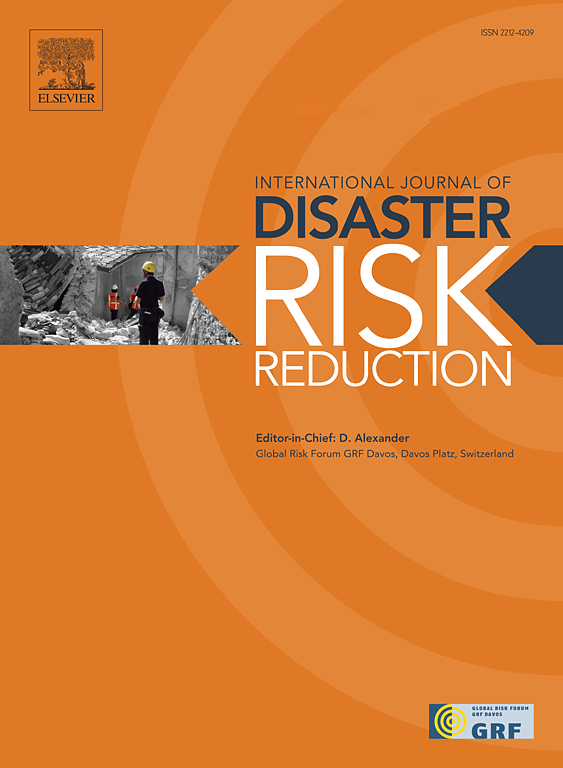Understanding residents' responses towards disaster-related urban emergency management: A case study of typhoons in Shenzhen, China
IF 4.2
1区 地球科学
Q1 GEOSCIENCES, MULTIDISCIPLINARY
International journal of disaster risk reduction
Pub Date : 2025-04-29
DOI:10.1016/j.ijdrr.2025.105533
引用次数: 0
Abstract
A comprehensive understanding of residents' responses to disaster emergencies is crucial for developing effective emergency strategies, whilst this critical problem remains underexplored in the existing literature. This study proposes an analytical framework that leverages publicly available social media data to model residents' behaviours in response to disaster emergencies and capture their underlying determinants. The framework integrates a hazard-based model and a binomial logistic regression model to examine how residents' response time and emotional states are associated with emergency measures, hazard characteristics and demographic factors. The framework is applied to examine public responses to five typhoons that affected Shenzhen, China, from 2018 to 2023. Our findings reveal notable heterogeneity in response patterns across different typhoon events, with behaviours primarily determined by hazard characteristics and emergency measures, rather than gender. Specifically, residents' responses are closely linked to typhoon-induced meteorological characteristics, underscoring the need to tailor emergency strategies to these features rather than relying solely on typhoon intensity metrics. In addition, emergency measures, including early disaster warnings, work suspension and increasing emergency funding, are found to improve response efficiency and reduce negative emotional reactions. The empirical insights from this study inform the development of context-specific, adaptive emergency strategies for Shenzhen and similar regions, while the proposed framework offers a scalable approach for analysing public responses more broadly.
了解居民对灾害相关城市应急管理的反应:以深圳台风为例
全面了解居民对灾害紧急情况的反应对于制定有效的应急战略至关重要,而这一关键问题在现有文献中仍未得到充分探讨。本研究提出了一个分析框架,利用公开可用的社交媒体数据来模拟居民应对灾害紧急情况的行为,并捕捉其潜在的决定因素。该框架整合了基于灾害的模型和二项逻辑回归模型,以研究居民的反应时间和情绪状态与应急措施、灾害特征和人口因素之间的关系。该框架应用于调查公众对2018年至2023年影响中国深圳的五次台风的反应。我们的研究结果揭示了不同台风事件的响应模式的显著异质性,其行为主要由灾害特征和应急措施决定,而不是由性别决定。具体而言,居民的反应与台风诱发的气象特征密切相关,强调需要根据这些特征量身定制应急策略,而不是仅仅依赖台风强度指标。此外,包括早期灾害预警、停工和增加应急资金在内的应急措施可以提高应对效率,减少负面情绪反应。本研究的经验见解为深圳和类似地区制定具体情况的适应性应急策略提供了信息,而所提出的框架为更广泛地分析公众反应提供了可扩展的方法。
本文章由计算机程序翻译,如有差异,请以英文原文为准。
求助全文
约1分钟内获得全文
求助全文
来源期刊

International journal of disaster risk reduction
GEOSCIENCES, MULTIDISCIPLINARYMETEOROLOGY-METEOROLOGY & ATMOSPHERIC SCIENCES
CiteScore
8.70
自引率
18.00%
发文量
688
审稿时长
79 days
期刊介绍:
The International Journal of Disaster Risk Reduction (IJDRR) is the journal for researchers, policymakers and practitioners across diverse disciplines: earth sciences and their implications; environmental sciences; engineering; urban studies; geography; and the social sciences. IJDRR publishes fundamental and applied research, critical reviews, policy papers and case studies with a particular focus on multi-disciplinary research that aims to reduce the impact of natural, technological, social and intentional disasters. IJDRR stimulates exchange of ideas and knowledge transfer on disaster research, mitigation, adaptation, prevention and risk reduction at all geographical scales: local, national and international.
Key topics:-
-multifaceted disaster and cascading disasters
-the development of disaster risk reduction strategies and techniques
-discussion and development of effective warning and educational systems for risk management at all levels
-disasters associated with climate change
-vulnerability analysis and vulnerability trends
-emerging risks
-resilience against disasters.
The journal particularly encourages papers that approach risk from a multi-disciplinary perspective.
 求助内容:
求助内容: 应助结果提醒方式:
应助结果提醒方式:


